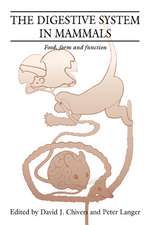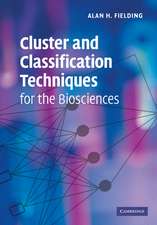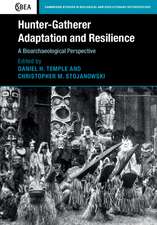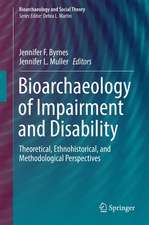Studies in Forensic Biohistory: Anthropological Perspectives: Cambridge Studies in Biological and Evolutionary Anthropology, cartea 75
Editat de Christopher M. Stojanowski, William N. Duncanen Limba Engleză Hardback – 4 ian 2017
| Toate formatele și edițiile | Preț | Express |
|---|---|---|
| Paperback (1) | 342.63 lei 6-8 săpt. | |
| Cambridge University Press – 24 iun 2020 | 342.63 lei 6-8 săpt. | |
| Hardback (1) | 566.50 lei 3-5 săpt. | |
| Cambridge University Press – 4 ian 2017 | 566.50 lei 3-5 săpt. |
Din seria Cambridge Studies in Biological and Evolutionary Anthropology
-
 Preț: 479.80 lei
Preț: 479.80 lei -
 Preț: 390.85 lei
Preț: 390.85 lei - 14%
 Preț: 750.86 lei
Preț: 750.86 lei - 11%
 Preț: 700.59 lei
Preț: 700.59 lei - 14%
 Preț: 722.61 lei
Preț: 722.61 lei - 9%
 Preț: 846.81 lei
Preț: 846.81 lei - 11%
 Preț: 460.98 lei
Preț: 460.98 lei -
 Preț: 367.91 lei
Preț: 367.91 lei - 11%
 Preț: 693.77 lei
Preț: 693.77 lei -
 Preț: 356.37 lei
Preț: 356.37 lei - 11%
 Preț: 633.61 lei
Preț: 633.61 lei - 11%
 Preț: 619.90 lei
Preț: 619.90 lei -
 Preț: 396.29 lei
Preț: 396.29 lei -
 Preț: 279.00 lei
Preț: 279.00 lei -
 Preț: 304.74 lei
Preț: 304.74 lei -
 Preț: 371.32 lei
Preț: 371.32 lei -
 Preț: 376.06 lei
Preț: 376.06 lei -
 Preț: 332.66 lei
Preț: 332.66 lei -
 Preț: 421.01 lei
Preț: 421.01 lei -
 Preț: 303.60 lei
Preț: 303.60 lei -
 Preț: 309.27 lei
Preț: 309.27 lei -
 Preț: 376.62 lei
Preț: 376.62 lei - 11%
 Preț: 424.92 lei
Preț: 424.92 lei -
 Preț: 308.50 lei
Preț: 308.50 lei -
 Preț: 317.11 lei
Preț: 317.11 lei -
 Preț: 453.33 lei
Preț: 453.33 lei -
 Preț: 322.41 lei
Preț: 322.41 lei -
 Preț: 433.83 lei
Preț: 433.83 lei -
 Preț: 435.78 lei
Preț: 435.78 lei -
 Preț: 471.93 lei
Preț: 471.93 lei - 11%
 Preț: 474.71 lei
Preț: 474.71 lei -
 Preț: 428.90 lei
Preț: 428.90 lei - 14%
 Preț: 934.70 lei
Preț: 934.70 lei
Preț: 566.50 lei
Preț vechi: 636.51 lei
-11% Nou
108.41€ • 112.77$ • 89.50£
Carte disponibilă
Livrare economică 24 martie-07 aprilie
Specificații
ISBN-10: 1107073545
Pagini: 350
Ilustrații: 76 b/w illus. 7 tables
Dimensiuni: 180 x 253 x 20 mm
Greutate: 0.84 kg
Editura: Cambridge University Press
Colecția Cambridge University Press
Seria Cambridge Studies in Biological and Evolutionary Anthropology
Locul publicării:New York, United States
Cuprins
List of contributors; Acknowledgements; 1. Defining an anthropological biohistorical research agenda: the history, scale, and scope of an emerging discipline Christopher M. Stojanowski and William N. Duncan; 2. Autopsy of past leaders: what remains tell us about them? Philippe Charlier; 3. Game of thrones: Richard III and the creation of cultural heritage Richard Toon and Laurie Stone; 4. The search for Don Francisco de Paula Marin: servant, friend, and advisor to King Kamehameha I, Kingdom of Hawaii Michael Pietrusewsky, Michele Toomay Douglas, Rona M. Ikehara-Quebral and Conrad Mac Goodwin; 5. Unearthing Robert Kennicott: naturalist, explorer, Smithsonian scientist Karin S. Bruwelheide, Sandra S. Schlachtmeyer, Douglas W. Owsley, Vicki E. Simon, Arthur C. Aufderheide, Larry W. Cartmell and Stephan J. Swanson; 6. The influence of the law on the post-mortem narratives of unknown human remains Ryan M. Seidemann; 7. The biohistory of prehistory: mummies and the forensic creation of identity Kenneth C. Nystrom; 8. Talking heads and other specters of the Mountain Meadows Massacre Shannon A. Novak; 9. Facial reconstruction of famous historical figures – between science and art Laura Buti, Giorgio Gruppioni and Stefano Benazzi; 10. The probabilistic basis for identifying individuals in biohistorical research Lyle W. Konigsberg and Lee Meadows Jantz; 11. Known unknowns: forensic science, the nation-state, and the iconic dead Sarah Wagner and Adam Rosenblatt; 12. The biohistory of atrocity and the social life of human remains Claire Moon; 13. Ethical issues in biohistory: NO easy answers! Jane E. Buikstra; 14. Theoretical facets of biohistorical research William N. Duncan and Christopher M. Stojanowski; Index.
Recenzii
Descriere
The lives of kings, poets, authors, criminals and celebrities are a perpetual fascination in the media and popular culture, and for decades anthropologists and other scientists have participated in 'post-mortem dissections' of the lives of historical figures. In this field of biohistory, researchers have identified and analyzed these figures' bodies using technologies such as DNA fingerprinting, biochemical assays, and skeletal biology. This book brings together biohistorical case studies for the first time, and considers the role of the anthropologist in the writing of historical narratives surrounding the deceased. Contributors theorize biohistory with respect to the sociology of the body, examining the ethical implications of biohistorical work and the diversity of social theoretical perspectives that researchers' work may relate to. The volume defines scales of biohistorical engagement, providing readers with a critical sense of scale and the different paths to 'historical notoriety' that can emerge with respect to human remains.




















